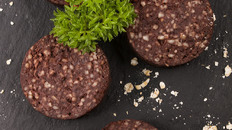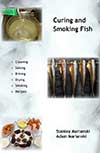Meats and Sausages
Black Pudding-Stornoway
The Scottish oatmeal used in Stornoway Black Puddings is responsible for its good, rough texture. No other seasonings are permitted and Stornoway Black Puddings must be free from artificial colors, flavors, bulking agents and preservatives. The Stornoway black pudding, made on the Western Isles of Scotland, has been granted Protected Geographical Indicator of Origin status in May 2013.
| Materials | Metric | US |
|---|---|---|
| Beef suet | 450 g | 0.99 lb |
| Oatmeal | 200 g | 0.44 lb |
| Blood | 200 g | 0.44 lb |
| Onion | 150 g | 0.33 lb |
Ingredients per 1000g (1 kg) of materials
| Salt | 15 g | 2-1/2 tsp |
| Pepper | 1.5 g | 3/4 tsp |
Instructions
- Cut suet. Commercial producers cleanly cut suet in bowl cutters into 1-5 mm pieces. In home production partially frozen suet can be manually cut into 3-5 mm pieces. It can be ground through 1/8” (3 mm) plate, however, particle definition will be poor due to fat smearing.
- Chop the onions finely.
- Mix all ingredients with blood. Where dried blood is used, water is added to rehydrate the blood; this method is used when large volumes of pudding are required as it is not possible to transport such volumes of liquid blood. The mixture should exhibit a thick porridge-like consistency which can still be stirred but with some effort.
- Stuff the mixture into large sausage casings using a stuffer. The skins are made from cellulose which is an organic compound produced for industrial use. Synthetic casings are used for the production of Stornoway Black Pudding due to large volumes required for commercial manufacture; however, natural casings may also be used in small scale production and subject to availability of animal intestines (sheep, cow, pig).
- Smaller amounts of sausage can be stuffed using a ladle by manually placing the sausage skin onto a large funnel.
- The ends are then either hand-tied with string or clipped by machine.
- The puddings are then boiled or steamed for up to 2.5 hours at temperatures between 70-86° C (158-186° F).
- Once cooked, each pudding is hung individually on a rack to cool gradually to an ambient temperature of 12° C (53° F), this can take between 2.5 - 4 hours. They are then placed in a chiller and stored at a temperature of 2° C (35° F).
Notes
In their original form the sausages are produced as 3 inch or 4 inch diameter (7.6 and 10.2 cm) cylindrical “sausage-shaped” puddings, varying in length from 18 cm to 50 cm and in weight from 0.5 kg to 1.36 kg, encased in skin. They may, however, be produced in other sizes and shapes to suit different customer requirements, e.g. a loop, or in slices.
Stornoway Black Puddings have a shelf-life of approximately one month.


















